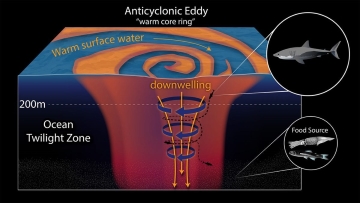680923_Swirling Fish_360 px width.jpg

Eddies are circular currents. Big fish, including tunas and sharks, were more abundant in the inner parts of Hawaiian eddies than the outer areas. Image ©Woods Hole Oceanographic Institution, N. Renier.
If you’re one of the ocean’s major predators, you go where the food is—even if it might make you a little dizzy. Scientists recently found that tunas, sharks, and other big fish were more common inside eddies in parts of the Pacific Ocean than in the surrounding water. And not surprisingly, that’s where the food was.
The scientists looked at records of waters inside the North Pacific Gyre. That’s a region from a little north of the equator to the central Pacific, and from the Americas to Japan. It’s the largest ecosystem in the world.
Across much of that region, there’s not much life in the upper layers. But there’s a lot more in the eddies—spinning currents that can be dozens of miles wide. They effect conditions not only at the surface, but far below as well. They can pull nutrient-rich waters from below, enhancing the number of fish that the big guys prey on.
The recent study looked at more than 20 years of records from a giant fishery around the Hawaiian islands—catches of both top-level predators and some of the species they feed on. They also looked at satellite observations of ocean currents over that same period. Comparing the two revealed that fishing lines inside eddies caught a lot more of 14 species of big fish—tunas, sharks, billfishes, and others—than lines outside the eddies.
So tracking eddies at the ocean surface may help pinpoint the best places to find big fish—and to manage this diminishing resource.

